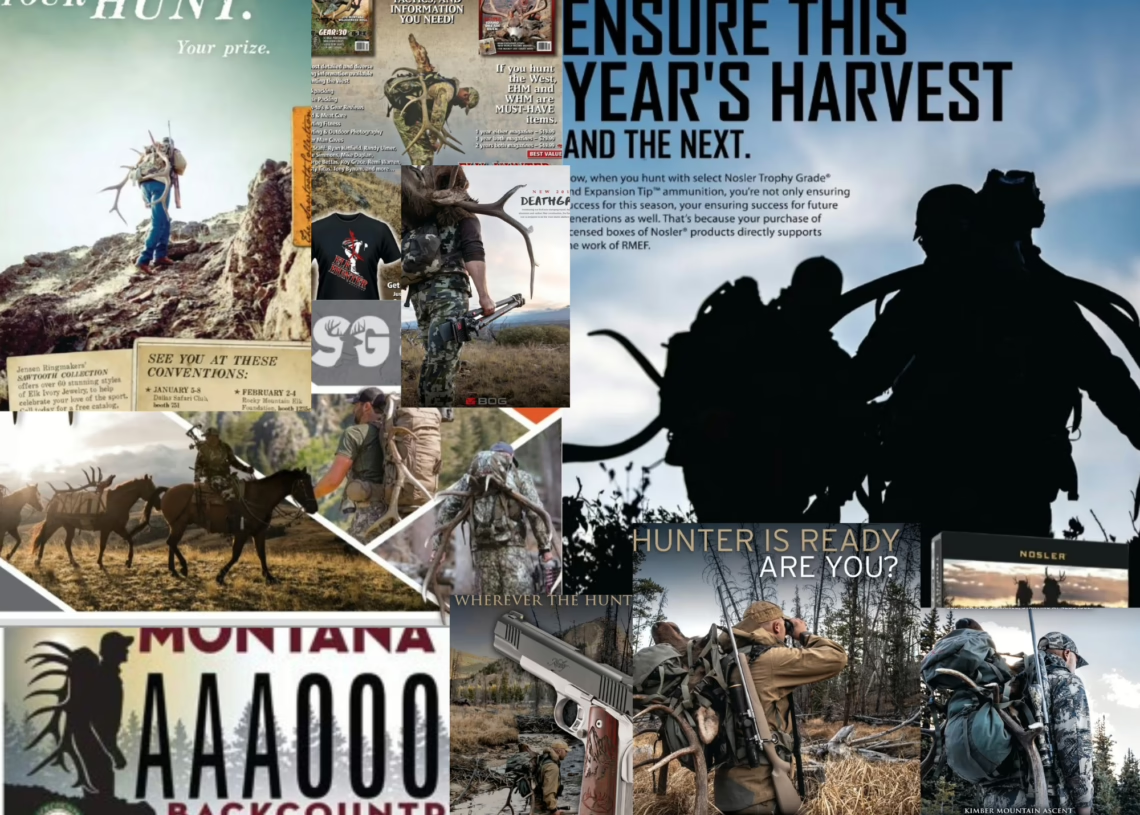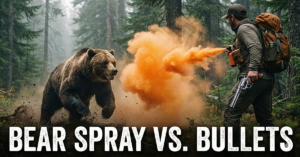There is a disconnect between ads targeted at hunters and the hunters themselves. Why should hunters care?
Do you take to the hills so you can shoot an elk in the next zip code? Do you then hack off its head and pack just the antlers back to the truck. No? That’s not how you do it? Then someone needs to tell the agencies creating the ads depicting us hunters doing that very thing.
The first few times I saw an ad featuring a dude (and they’re all dudes) packing out nothing more than the hacked-off head of an elk, I thought it was cool. That was about 20 years ago. Since then, nearly every company has imitated that ad. Not only do ad agencies seem to lack creativity, they lack connections to their audience. Worst of all, the image does hunting and hunters absolutely no favors.
Let’s assume this successful hunter is making his last trip out of the backcountry after packing all the meat. Good for him. That’s how it should be. Then again, let’s dissect this popular icon of the big game hunter from the point of view of someone who doesn’t hunt.
If you didn’t hunt, what would you think? Would you assume this hunter packed all the meat to the truck already? No, you would not because you don’t hunt. All you see is what’s presented—some dude who killed an animal lopped off its head and brought it back home for his trophy room. Is this what hunters want non-hunters to think we do?
To be fair, these ads produced for the collage in the opening photo were plucked from hunting magazines, which is not something a non-hunter might spend an evening reading. And yet, the same image has reached mainstream audiences, from the grocery store aisle to Main Street. Take the license plate supporting Backcountry Hunters and Anglers (BHA) in Montana. I applaud BHA for what they stand for. However, the license plate prominently features the outline of a man packing out an elk rack. Unlike hunting magazines, these plates are seen by anyone paying attention at a red light.

Is Hunting Advertising Adversarial Toward Wildlife?
It’s hard to get people to buy stuff—unless you make bullets. Suppliers can’t keep up with demand even when a box of ammo averages $3/bullet. It’s for this reason that makes me wonder why the messaging in their advertising is adversarial toward wildlife.
One ad features a “stud buck” vs. a ” bullet that “asserts dominance from the next zip code.”
Ballistics technology is so advanced today that my bullet will fly wherever I want it to go, regardless of crosswind, atmospheric pressure, or distance. (That’s sarcasm.) The promise reminds me of Jack and the Beanstalk. If I trade my $50 for just a handful of these magic bullets, I can shoot as far as I can see. And maybe at the end, there will be a giant dead elk.
Why not celebrate how close we get before taking a shot? We are pitting our skills against a creature that eats, sleeps, lives, and breathes outdoors every moment of its short life. According to this advertising, hunters don’t have enough of our ancestors’ grit and skill to get the job done in under 800 yards. It’s insulting.
What the Data Says: Most Americans Disapprove of Hunting for Sport or Trophy

Advertising exists to sell you something, be it a bullet, an impossible dream, or a magic bean. It’s meant to be over the top and stick with you, like those obscurely hilarious Matthew McConaughey ads for Lincoln. Unlike automobile ads, though, hunting is a divisive topic.
A 2019 study found that 80 percent of Americans approve of hunting, but there’s a catch. “When the reasons are utilitarian in nature—for meat, to protect humans or property, for wildlife management—approval is very high, but hunting drops substantially when the reason is for the sport or for the challenge; meanwhile, less than a third of Americans approve of hunting for a trophy.”
Let that sink in: less than 33 percent of Americans approve of trophy hunting. The public doesn’t mind if we go hunting, but our primary motivation can’t be just to put some antlers on the wall. In addition, our country has laws against wanton waste. Even if we did kill a brusier, we still need to pack it out and eat it. But where in advertising does it shows hunters humping out those hindquarters? Sometimes, ads do that. Most often, they do not.
When ads show just a rack being packed out, it is no wonder that more than 60 percent of the public disagrees with that. Hell, I disagree with it, too. Where’s the meat? Hunters need to win in the court of public opinion because our numbers are dwindling. Randy Newberg once told me that hunters better damn well care about what that housewife in Cleveland thinks about hunting, and he’s absolutely right. Recall the recent attempt to sell millions of acres of public land. That nonsense was killed by a coalition of hunting groups together with other public land advocates ranging from the Outdoor Industry Association to The Wilderness Society. As for the anti-hunters, they are beginning to wield more power in state fish and game agencies. We’re not making more hunters, and that’s a problem. Is advertising as big a deal as chronic wasting disease or the politicization of fish and game commissions? No, it’s not, but all these things are connected to the image of hunting.

The Solution: Promote Meat Hunting and The North American Model of Conservation
Years ago, I saw a hunting industry ad with a photo of an open chest freezer stacked full of white packages labeled deer steaks, hamburger, and sausage. The caption read “Trophy Room.” What a straightforward yet powerful ad. It spoke to me, and it made me think that someone out there feels like I do. We need more of this. The person who created that ad was a hunter, and they understood what we do.
Maybe, just maybe, there are ad agencies out there with hunters on staff. Perhaps they have heard of the North American Model of Wildlife Conservation and the concept of Fair Chase. No, these aren’t as sexy as some scowling hunter covered in face paint pretending to haul an elk head out of the backcountry. But if agencies and creative directors are worth the checks they’re cashing, they will find a way.
You don’t have to make ads with guys straight out of special forces sporting a sleeve of ink and enough protein powder in their gut to choke a goat. Too many ads depict hunters as operators stalking antlered insurgents among fields of clover. To all those companies out there, please rethink your creative. Just get back to why most of us get out there and hunt. We want to take a break from the routine. We want to make meat and be with friends. We want to be cold and miserable, but then warm up and have a laugh at the end of the day. We do like a challenge, but we’re not out there to die or hack the head off an elk and leave the meat to waste.
It’s time to ditch the image of the mighty head hunter. The tough-guy, kill ‘em all mentality isn’t going to sell more product, and it will turn the general public against us. We have to start consciously thinking about our image. It’s not time to circle the wagons and tell the world to piss off. It’s time to tell the world who we are, and it certainly isn’t how most advertisers depict us.







